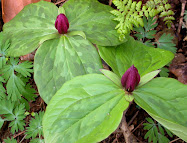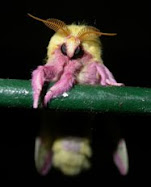
The Bombyliidae (bee flies) eggs are laid near the entrance to the nest of the specific bee host parasitized by that species of bee fly. The tiny larvae enter the nest and usually wait until the bee larva has pupated before metamorphosing from a small, mobile animal to a smooth, fat larva which feeds on the bee pupa. The bee fly pupa is dual-phased. The first pupa is ‘normal’; the second stage has a sharp battering ram with which to break down the nest cell wall, made by the adult bee when closing the cell.
++DSCN9979.jpg)
Dreamy Duskywing (Erynnis icelus) has one brood from April to early July; perhaps a rare second brood in the southern Appalachian Mountains. Caterpillar hosts: Willows (Salix), poplars, aspens (Populus), and occasionally birch (Betula).

Eastern Red Spotted Newt (Notophthalmus viridescens) During the breeding season, males can be easily identified by their enlarged hind legs, with black-horny structures on the inner surfaces of their thighs and toe tips (used for gripping females during mating), swollen vents, and broadly keeled (high-wavy crest) tails.

Gray Tree Frog (Hyla versicolor). As the species name Hyla versicolor implies, gray tree frogs are highly variable in color owing to their ability to camouflage themselves from gray to green, depending on the substrate they are sitting on. The degree of mottling varies. They can change from nearly black to nearly white. They change colors more slowly than a chameleon.

Field Pussytoes (Antennaria neglecta). Some authorities state that this is primarily a wind-pollinated plant, while others emphasize the role of insects in promoting cross-pollination. Primarily small bees and flies visit the flowers, including Halictid bees, Andrenid bees, Cuckoo bees, Syrphid flies, Muscid flies, and Blow flies (Robertson, 1929). The caterpillars of the butterfly Vanessa virginiensis (American Painted Lady) feed on the foliage.




+DSCN5800+for+blog.jpg)




1 comment:
Phenomenal photos, Squirrel! Thanks for smartening me up with amazing nature facts too!
Post a Comment